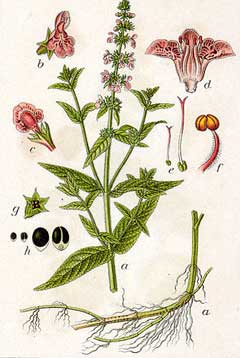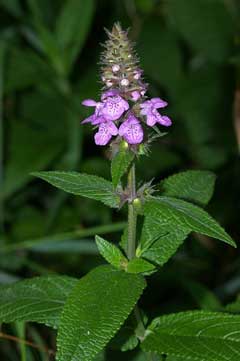 |
|
http://commons.wikimedia.org/wiki/File:Stachys_palustris_Sturm45.jpg |
 |
| http://commons.wikimedia.org/wiki/User:Fice |
Translate this page:
Summary
Physical Characteristics

 Stachys palustris is a PERENNIAL growing to 1 m (3ft 3in) by 0.4 m (1ft 4in).
Stachys palustris is a PERENNIAL growing to 1 m (3ft 3in) by 0.4 m (1ft 4in).
See above for USDA hardiness. It is hardy to UK zone 5 and is not frost tender. It is in flower from July to September, and the seeds ripen from August to October. The species is hermaphrodite (has both male and female organs) and is pollinated by Bees.
It is noted for attracting wildlife.
Suitable for: light (sandy), medium (loamy) and heavy (clay) soils and prefers well-drained soil. Suitable pH: mildly acid, neutral and basic (mildly alkaline) soils. It can grow in semi-shade (light woodland) or no shade. It prefers moist or wet soil.
UK Hardiness Map
US Hardiness Map
Synonyms
Stachys aquatica Bubani. Stachys austriaca Heynh. Stachys maeotica Postrig.
Plant Habitats
Bog Garden; Cultivated Beds;
Edible Uses
Edible Parts: Leaves Root Seed Shoots
Edible Uses:
Tubers - raw or cooked[K]. A wholesome and nutritious food[4], they have a pleasant mild nutty flavour[K]. The tubers can be dried and ground into a powder that is used in making bread etc[2, 4, 12, 115, 183]. The tubers are formed in the autumn[17]. Although quite small, they are fairly smooth and produced in a reasonable quantity so are not too fiddly to utilize[K]. Young shoots - cooked. Used as an asparagus substitute[183]. A pleasant taste but the smell is disagreeable[4]. Seed[257]. No further details are given[257].
References More on Edible Uses
Medicinal Uses
Plants For A Future can not take any responsibility for any adverse effects from the use of plants. Always seek advice from a professional before using a plant medicinally.
Antiseptic Antispasmodic Emetic Emmenagogue Expectorant Haemostatic Nervine Sedative
Tonic Vulnerary
The plant is antiseptic, antispasmodic, emetic, emmenagogue, expectorant, haemostatic, nervine, sedative, tonic, vulnerary[4, 61, 218]. The plant has been highly valued for its wound-healing activity, being effective against both internal and external bleeding, and is also used in the treatment of gout, cramps and pains in the joints[4]. The herb is harvested in the summer when just coming into flower and can be dried for later use[4].
References More on Medicinal Uses
The Bookshop: Edible Plant Books
Our Latest books on Perennial Plants For Food Forests and Permaculture Gardens in paperback or digital formats.

Edible Tropical Plants
Food Forest Plants for Hotter Conditions: 250+ Plants For Tropical Food Forests & Permaculture Gardens.
More

Edible Temperate Plants
Plants for Your Food Forest: 500 Plants for Temperate Food Forests & Permaculture Gardens.
More

More Books
PFAF have eight books available in paperback and digital formats. Browse the shop for more information.
Shop Now
Other Uses
References More on Other Uses
Cultivation details
Requires a moist soil for good root production[2, 24]. A good bee plant[24]. All parts of the plant emit an unpleasant smell when bruised[245]. For polyculture design as well as the above-ground architecture (form - tree, shrub etc. and size shown above) information on the habit and root pattern is also useful and given here if available. The plant growth habit is a clumper with limited spread [1-2]. The root pattern is rhizomatous with underground stems sending roots and shoots along their length [1-2].
References Carbon Farming Information and Carbon Sequestration Information
Temperature Converter
Type a value in the Celsius field to convert the value to Fahrenheit:
Fahrenheit:
The PFAF Bookshop
Plants For A Future have a number of books available in paperback and digital form. Book titles include Edible Plants, Edible Perennials, Edible Trees,Edible Shrubs, Woodland Gardening, and Temperate Food Forest Plants. Our new book is Food Forest Plants For Hotter Conditions (Tropical and Sub-Tropical).
Shop Now
Plant Propagation
Seed - sow spring in a cold frame. Prick out the seedlings into individual pots once they are large enough to handle and plant them out in the summer. Division in spring. Larger divisions can be planted out direct into their permanent positions. We have found it best to pot up the smaller divisions and grow them on in a lightly shaded position in a cold frame, planting them out once they are well established in the summer.
Other Names
If available other names are mentioned here
Native Range
TEMPERATE ASIA: Armenia, Azerbaijan, China, Ciscaucasia, Eastern Siberia, Kazakhstan, Kyrgyzstan, Mongolia, Russian Federation-Ciscaucasia, Russian Federation-Eastern Siberia, Russian Federation-Western Siberia, Tajikistan, Turkey (north), Western Siberia, Xinjiang Uygur Zizhiqu,Iran (northwest). TROPICAL ASIA: India, Jammu and Kashmir, Pakistan (northeast), EUROPE: Denmark, Finland, United Kingdom (U.K.), Ireland, Norway, Sweden, Czechoslovakia (Czech Republic and Slovakia), Austria, Belgium, Switzerland, Germany, Hungary, Netherlands, Poland, Russian Federation-European part, European part, Belarus, Estonia, Lithuania, Latvia, Ukraine (incl. Krym), Former Yugoslavia, Albania, Bulgaria, Greece, Italy, Romania, Spain, France (incl. Corsica), Portugal,
Weed Potential
Right plant wrong place. We are currently updating this section.
Please note that a plant may be invasive in one area but may not in your area so it's worth checking.
Conservation Status
IUCN Red List of Threatened Plants Status :

Growth: S = slow M = medium F = fast. Soil: L = light (sandy) M = medium H = heavy (clay). pH: A = acid N = neutral B = basic (alkaline). Shade: F = full shade S = semi-shade N = no shade. Moisture: D = dry M = Moist We = wet Wa = water.
Now available:
Food Forest Plants for Mediterranean Conditions
350+ Perennial Plants For Mediterranean and Drier Food Forests and Permaculture Gardens.
[Paperback and eBook]
This is the third in Plants For A Future's series of plant guides for food forests tailored to
specific climate zones. Following volumes on temperate and tropical ecosystems, this book focuses
on species suited to Mediterranean conditions—regions with hot, dry summers and cool, wet winters,
often facing the added challenge of climate change.
Read More
Expert comment
Author
L.
Botanical References
17
Links / References
For a list of references used on this page please go here
Readers comment
© 2010, Plants For A Future. Plants For A Future is a charitable company limited by guarantee, registered in England and Wales. Charity No. 1057719, Company No. 3204567.